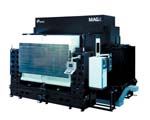Better HSM For Big Parts
'High speed machining' is accepted and commonplace in many shops. HSM is so widely used, in fact, that its acceptance is beginning to affect the design of machine tools.
Share





The term is widely used because the practice is now widely used as well. "High speed machining" is accepted and commonplace in many shops. HSM is so widely used, in fact, that its acceptance is beginning to affect the design of machine tools.
The practice began as a way to use existing CNC machining centers more effectively. Indeed, when most shops first started experimenting with HSM, they did so on a machine they already had in house. Perhaps the spindle or control was upgraded, but any productivity improvement came from changes in the process and machining strategy as much as from changes to the machine. Establishing a process for precision milling with fast, light cuts in mold shops, for example, allowed many cores and cavities to be milled complete, without EDM or polishing. And in aerospace-industry shops, similar methods allowed aircraft structural components to be milled in one large piece in a short amount of time, reducing the need for assembly.
In both of these applications—mold making and aerospace—enough work is now being done through high speed machining that a next step is appropriate. Machine tools, particularly machines for large and expensive workpieces, can be designed specifically with these HSM applications in mind.
Two examples of such machines come from Makino (Mason, Ohio). Both improve the productivity and effectiveness of HSM processes currently in use on more standard CNC machining centers.
Big Molds In One Stop
The MCC2013 horizontal machining center accommodates molds and dies up to 22,000 pounds and up to 98 inches long. The machine was developed for large automotive molds such as those used to make bumpers, door trim or headlamp assemblies, and for the large appliance molds producing printer and copier cases or the back panels of big-screen TVs.
High speed machining applied to these big molds is often used for finishing only. Roughing generally occurs on a slower, more powerful machine that takes deep cuts and leaves lots of material behind for the finishing machine. The design of the MCC2013 seeks to combine power, speed and precision in one place so HSM techniques can be applied to roughing and finishing both—meaning the part can be milled complete in one setup.
A large workpiece exaggerates many of the challenges standing in the way of this goal. For example, the weight of the workpiece potentially increases the force of friction in the axis ways beneath the table. Also, thermal error that may be the same in percentage terms when compared to a smaller workpiece becomes more significant in dimensional terms because of the increased scale of the work.
Special features of the machine specifically address these challenges. In the axes, air pressure creates what Makino calls "semi-floating" guideways. The use of air in the guideways smooths axis motion and permits more accurate positioning.
To minimize thermal error, cooling oil circulates through the spindle and through the column. It can also circulate through an optional angle plate supporting the work. To bring cooling even closer to the work, another option is air conditioning for the space within the machine's enclosure.
The spindle has 15,000 rpm with 40 hp standard or 67 hp optional. The fact that the machine orients the spindle horizontally is yet another high speed machining feature. HSM applied to roughing results in a high rate of chip generation—a problem similar to that of high speed milling of aluminum for aerospace work. The machine solves this problem the same way many aerospace machines do; horizontal machining lets the chips fall away. On the MCC2013, a chip conveyor is another optional feature.
Accelerated Aerostructures
The MAG4 machining center for aerospace work is available with workhandling engineered for the rectangular billet that is the starting point for monolithic aerostructures machined through HSM.
An automated overhead gripper for these workpieces delivers the stock to a pallet indexer that rotates about a horizontal pivot. For loading, this indexer holds the table facing up. The indexer then turns the work 90 degrees for machining with the horizontal spindle. This system for workhandling provides part-to-part production efficiency to complement the machining efficiency of high speed milling.
The spindle head on this five-axis machine has no external cables to get in the way of its rotary-axis movement. The head is capable of continuous and unrestricted motion in the C axis (through 360 degrees and beyond) and better than 180 degrees of motion in A. The spindle is capable of 30,000 rpm.
The machine's X axis—its longest axis—is driven by linear motors for precise high-feed-rate motion across the long travel. The 4 in "MAG4" stands for 4 meters, the length of this travel. Longer-travel versions of the machine are also available, up to MAG16.
Related Content
How to Accelerate Robotic Deburring & Automated Material Removal
Pairing automation with air-driven motors that push cutting tool speeds up to 65,000 RPM with no duty cycle can dramatically improve throughput and improve finishing.
Read MoreRead Next
Setting Up the Building Blocks for a Digital Factory
Woodward Inc. spent over a year developing an API to connect machines to its digital factory. Caron Engineering’s MiConnect has cut most of this process while also granting the shop greater access to machine information.
Read More5 Rules of Thumb for Buying CNC Machine Tools
Use these tips to carefully plan your machine tool purchases and to avoid regretting your decision later.
Read MoreBuilding Out a Foundation for Student Machinists
Autodesk and Haas have teamed up to produce an introductory course for students that covers the basics of CAD, CAM and CNC while providing them with a portfolio part.
Read More































